The subject of our talk today is the magnificent painting behind me, Charles I and Henrietta Maria with their two eldest children, Prince Charles (later King Charles II) and Princess Mary, a composition better known as the ‘Greate Peece’. This particular painting was described in 2004 by the Van Dyck scholar, the late Sir Olivar Millar, Surveyor of Her Majesty the Queen’s Pictures, as an ‘important copy’ after the painting by Van Dyck now hanging at Windsor Castle. But – research done by a Chelsea Pensioner over one hundred years ago, re-revealed today, suggested that this painting might in fact be Van Dyck’s original rather than a copy. So, the title of our talk is ‘The Royal Hospital ‘Greate Peece’ – Van Dyck or not Van Dyck’?
How to cite: Davies, Justin and Innes-Mulraine, James. “Van Dyck or not Van Dyck? The ‘Great Peece’ at the Royal Hospital Chelsea, London” In Jordaens Van Dyck Panel Paintings Project.
http://jordaensvandyck.org/article/the-royal-hospital-greate-peece-van-dyck-or-not-van-dyck/ (accessed 10 July 2025)
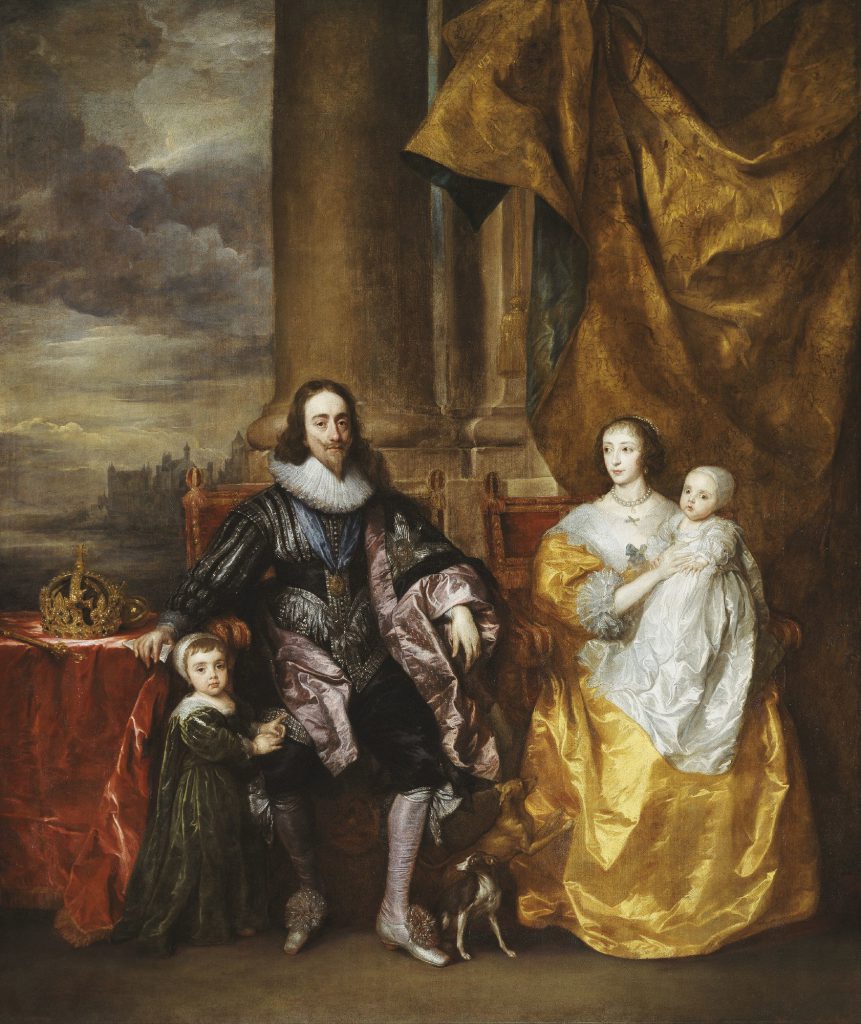
Anthony Van Dyck was born in Antwerp in 1599 but is of course most closely associated with the doomed court of Charles I, from Van Dyck’s second stay in England from 1632 until his death in Blackfriars in 1641. A child prodigy and a genius, he is perhaps the greatest portrait painter that ever lived. When Thomas Gainsborough died in 1788, his last words were reportedly “We are all going to heaven and Van Dyck is of the party.”
With the exception of two small black and white sketches executed in England, one of which we will discuss later, Van Dyck painted on oak panels only whilst he was living on the continent. These were mainly religious subjects and some portraits, large and small. They included a number of Apostles, who were a very popular subject in counter-reformation Antwerp.
Their brilliance is that they are in fact portraits of living persons who served as studio models. And Van Dyck’s brilliance as a portrait painter was evident even in his teens. So popular were these paintings that they were seemingly endlessly copied by other artists and to date, we have seen and examined a tremendous number of Bearded Apostles. So, it’s a pleasure to be giving a talk today on something other than a bearded apostle.
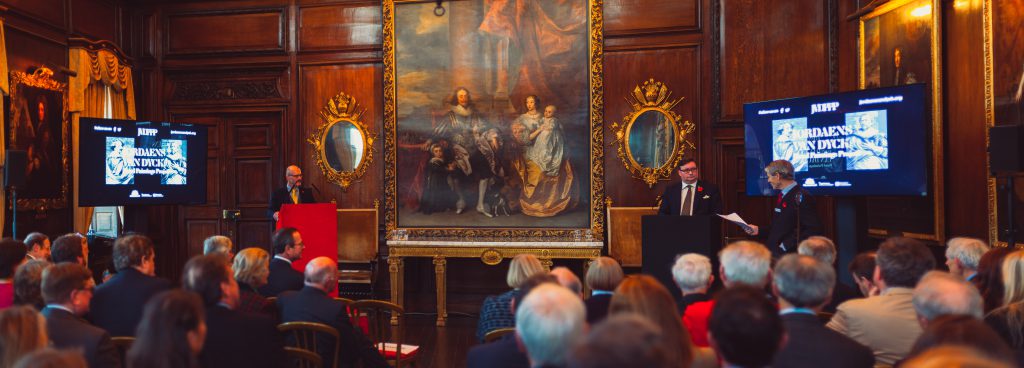
As well as examining every panel painting we can find by Jordaens and Van Dyck across the world – from Puerto Rico to Saint Petersburg – dating the wood, matching the wood with other paintings where possible and noting the names of the panel makers when their marks are still present and visible on the reverse of the panel, some 400 years after they were made, the project is also conducting new archival research into Van Dyck and Jordaens across borders – in Belgium, France, Germany, Italy and the United Kingdom. Part of this research process includes revisiting primary sources in archives to hunt for new or previously overlooked clues and also consulting the archives of distinguished Van Dyck scholars.
It was on such a quest that James Innes-Mulraine and I found ourselves in the Heinz Library and Archive at the National Portrait Gallery on a cold December morning in 2017. We were there to examine the Van Dyck archive of the late Sir Lionel Cust, a former Director of the National Portrait Gallery and Surveyor of the King’s Pictures. In 1900, Cust had written the first substantial English monograph on Van Dyck.
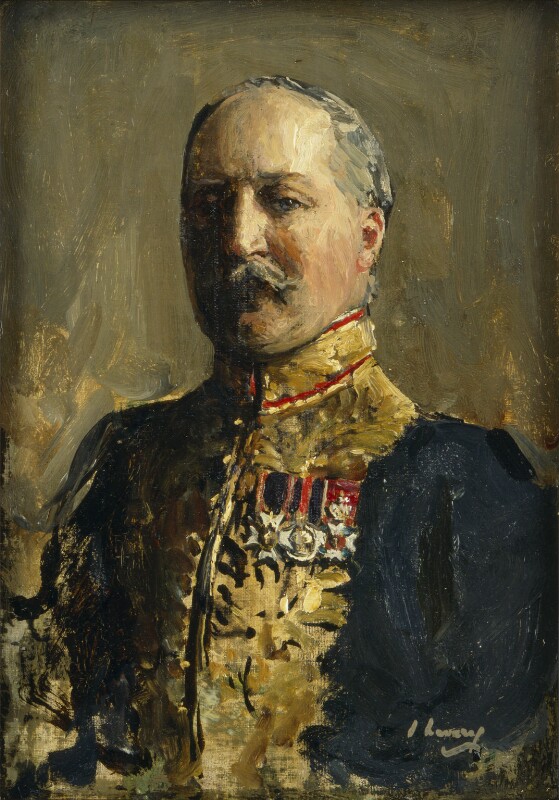
Lionel Cust, born in 1859, joined the Civil Service after Eton and Cambridge. His first posting was to the War Office on Pall Mall, where his reputation as the top classical scholar of his year at Cambridge went unrecognised. Instead, he was appointed a Clerk to Department of the Financial Secretary, Sub Division F3, where his duties were to record and examine the accounts of all the Regimental Paymasters in the British Army. Not unsurprisingly, in his own words, Cust found this work ‘uncongenial’. Others record that he performed poorly. After two years of this misery he was happily transferred to the Print Room of the British Museum. In 1895 he was appointed Director of the National Portrait Gallery and simultaneously, in 1901, Surveyor of the King’s Pictures and Works of Art. Unfortunately, from an art historian’s point of view, his posthumously published memoir. ‘Edward VII and His Court’, has little to do with paintings. They only mention Van Dyck once in passing and they are more concerned with his time as a Gentleman Usher to King Edward VII, to which position he was also appointed in 1901. Whilst Van Dyck is only mentioned once, three pages are dedicated to the uniform of a Gentleman Usher – a job Cust equated to one of glorious crowd control – and it is the Gentleman Usher’s uniform he is wearing in this splendid portrait by Sir John Lavery.
Though we do learn from his memoirs that Queen Victoria’s predilection for collecting white marble busts led to a nearly disastrous experiment after King Edward the VII’s accession throne in 1901. The King decided to disperse the busts of his mother’s collection around Windsor Castle, and some of them, including his father Prince Albert and the brothers and sons of King George III were arranged around the walls of St George’s Hall. When the busts were placed in the hall, the whiteness of the marble appeared incongruous against the dark wood panelling. It was suggested that the coldness of the white surfaces could be tempered with a solution of tea applied to the marble. This was done and appeared to work well for three days. On the fourth day it was noticed that Prince Albert seemed to be sporting a chestnut coloured toupee and that various Hanoverians were in danger of becoming similarly bewigged. The tea solution was rapidly scrubbed off.
Cust’s reputation as an art historian was formidable and he authored a number of well received monographs and catalogues. He was forthright; his obituary in the Spectator in 1929 noted that ‘he was much bolder in attributing doubtful pictures to particular painters than one would have expected of a man with his training. His championship of an attribution when he found himself in a minority of one was often entertainingly vigorous.’ He lived in a glorious period of discoveries in country houses, many of which he made himself. ‘A Turk by Tintoretto’ in the library at Newbattle in Midlothian was actually a Rembrandt. And the exquisite miniature, ‘The Execution of Mary Queen of Scots’, in the collection of Earl Beauchamp at Madresfield, had been badly misidentified over the centuries. It was in fact Queen Elizabeth washing the feet of the poor on Maundy Thursday.
We had been looking in Cust’s archive at the National Portrait Gallery for references to panel paintings. It was a great surprise when we found a remarkable series of correspondence between Sir Lionel and Corporal Charles Dyas, an In-Pensioner here at the Royal Hospital Chelsea. Dyas claimed, with good reason, in 1902 that the painting behind me was the original by Van Dyck and that the version in the Royal Collection was merely a copy. From thence sprung an unusual and extraordinary art historical collaboration between Cust and Dyas.
At first glance, the Corporal and the courtier made an unlikely team. Dyas, a Shropshire grocer, had enlisted in the 1st Life Guards in 1861 at the age of twenty. His 19-year service spanned the period between the Crimean War and the Egyptian campaigns, and was spent on ceremonial duty based at Windsor and Regent’s Park Barracks. In 1880 he was discharged as unfit, his eyesight damaged by rheumatic iritis contracted from living under canvas.
He became an out-pensioner of the Royal Hospital on a pension of 11 pence per day, but he was still only 39 and he married a widow, Sarah Frockingham a month after his discharge. He became a coffee-house keeper and step-father to her two daughters, living at Albany Street, St Pancras, still close to Regent’s Park Barracks. In the 1880s they moved to Winchester where Dyas became the landlord of the Plume of Feathers pub.
On 1st December 1896, by then a widower and without dependents, Charles Dyas entered the Royal Hospital as an In-Pensioner living on Ward 22. Three things stood out about him: the first is that he stood six foot six in his boots and was popularly known at the Royal Hospital as ‘the Giant´. Second, that at a youthful 55, he was the ‘youngest man’ of the hospital and therefore known as its ‘baby’. And, thirdly, that he had no wish for an easy retirement. He promptly set about fighting for the Chelsea Pensioners’ right to vote and researching a history of the Royal Hospital.
While researching in the Royal Hospital archives in the State Paper Office at Somerset House and in the House of Lords Library, he made several significant discoveries about the ‘Greate Peece’. These led him to write a bold memorandum to the Surveyor of the King’s Pictures Sir Lionel Cust, proposing that the version of the ‘Greate Peece’ hanging in his Hospital was the original by Van Dyck and that the version in the King’s collection, then hanging in the Van Dyck room at Windsor Castle, was only a copy.
The Greate Peece is one of Van Dyck’s most famous paintings, a seemingly effortless rendition of kingship. It suggests presence, power, and dynastic harmony. It encapsulates Van Dyck’s genius, he takes a scene so casual and realistic, a young family at home, and makes it resonate with symphonic grandeur. Nothing like it had been seen in England since an unknown artist painted this portrait for King Henry VIII – a picture that Van Dyck would have seen at Whitehall. Van Dyck takes informal majesty to the next level, showing the King as human and divine simultaneously.
Van Dyck instinctively recognised Charles’s vision of himself and his kingship. The Great Peece was the first portrait Van Dyck painted when he returned to England in 1632, and promotion was swift. He was knighted in June and made ‘principal paynter in ordinarie’ to the King. In August he was paid £100 by Privy Seal Warrant for ‘One great peece of our royall selfe, Consort and children’. Given the success of this painting, it is no wonder that Charles I wanted to keep Van Dyck in England. His virtuosity found beauty in mundane sitters, without losing their likeness, though when Prince Rupert of the Rhine’s sister, Sophia Electress of Hanover eventually met Queen Henrietta Maria she was disappointed that the Queen did not resemble the beautiful portraits of Van Dyck. Instead she was a much smaller woman and Sophia remarked that she had ‘crooked shoulders and teeth protruding from her mouth like guns from a fort.’
One can imagine Sir Lionel Cust’s surprise when he read the Chelsea Pensioner’s Memorandum in which Dyas made three serious and substantial points:
Lionel Cust took the Chelsea Pensioner’s Memorandum and proposal seriously. As Surveyor of the King’s Pictures, he was doubtless a little concerned to read that the King’s picture might only be a copy. Cust and Dyas set out to investigate. They went to peer at the respective versions in Windsor and here at the Royal Hospital, one doubtless dressed in morning coat and the other in his Royal Hospital blues or scarlet. At this stage, it is necessary to conjure a vision of the fog, soot and gaslight that surrounded Edwardian London. It is to be remembered that both paintings would have been covered with thick, discoloured, yellowed varnish, encrusted by centuries of smoke from coal fires and candles in chandeliers. In addition, both paintings had lived turbulent lives, and had gone missing during the Interregnum. Indeed, the version at Windsor was in a dreadful condition. It had been restituted to Charles II by the bounty hunter Colonel Hawley in 1662 but then evacuated down the Thames to the Tower of London to keep it safe during the Great Fire in 1666. It then survived the Whitehall fire of April 9, 1691 but was manhandled out of the buildings in the process. It was later moved by William III to the new palace at Kensington where he erected a new picture gallery. Unfortunately, Kensington Palace also caught fire on November 12th, 1691 and the Greate Peece was again dragged from the wall to safety.
In order to examine Corporal Dyas’ claims as thoroughly as possible, Lionel Cust commissioned the royal restorers, Messrs Haines and sons to examine both paintings. This they did and they could determine that the Greate Peece in the Royal Collection had been extended to match the size of the equestrian portrait of Charles I by Van Dyck, when both were hung by William III in the new picture gallery at Kensington Palace. The dimensions of the Greate Peece were not reduced when the painting was subsequently moved to Windsor Castle. Messrs Haines and Sons realized that its original height and width before its late 17th century extension by William III did indeed match the size of the Whitehall painting recorded in Van der Doort’s catalogue of the collection of Charles I.
With regards to the missing dog in the Chelsea picture and the missing dog in Van der Doort’s catalogue, it was evident that there actually was a second dog, as you can see now, but over the centuries it had disappeared in to the folds of Henrietta Maria’s dress under the thick, yellowed varnish. And that the Windsor painting had also been in similarly bad condition, which probably led to the disappearing dog in Van der Doort’s catalogue. They also noted that the Chelsea painting bore some deliberate brush strokes of a copyist, rather than the vivacious brush strokes of Van Dyck himself.
It is to be much regretted that Charles Dyas died on March 30, 1907 before his history of the Royal Hospital was finished. Lionel Cust wrote up the story of the Greate Peece and published it in 1908 in the Burlington Magazine, of which he was editor, paying fulsome praise to the research of the Chelsea Pensioner. Cust’s conclusion was that the Windsor version was the original and that the Chelsea version was a copy, possibly executed by one Remigius Van Leemput, an artist who had worked with Van Dyck, as a 1643 payment by Charles I for a copy has survived, and perhaps the painting was commenced at an earlier date in the studio of Van Dyck. This conclusion matched the view of Sir George Scharf, Cust’s predecessor as Director of the National Portrait Gallery, who wrote to the Governor of the Royal Hospital in 1871 that, ‘the large picture of Charles 1st and family is excellent and was doubtless done in Vandyck’s studio under his own inspection.’
By this stage of our research, we were intrigued by Charles Dyas’ thorough scholarship and Lionel Cust’s equally scholarly responses. So, Justin and I set out to re-examine some primary sources and see whether we could add anything to the research on these paintings. And did Van Dyck have anything to do with this painting? Did he paint it as Dyas claimed or, as mentioned earlier, is it only an ‘important copy’ as listed in the latest Van Dyck catalogue by the late Sir Olivar Millar.
The first thing the panel paintings project did, as befits its name, was to examine, with the kind permission of H.M. The Queen, Van Dyck’s preliminary oil sketch on panel for the Greate Peece, which was acquired by the Royal Collection in 2016. It was examined at Windsor in September 2017. The small grisaille measures 27 by 20 cm. There were not enough tree rings on the edge of the panel for us to find a date for the wood at this stage but we hope to find one during the course of the project.
But what was apparent is that Van Dyck’s original thoughts were not only different in composition to the finished picture – which you can see in the placing of the children – but also of a different format to the completed picture. The oil sketch’s rectangular format matches the original rectangular bolt of canvas in the Windsor Greate Peece. It measures 6 foot 9 in height and 8 foot 2 in width. The painting was subsequently extended by Van Dyck. If this was a final technical piece of proof needed that the painting of the Greate Peece is Windsor is Van Dyck’s original then this it.
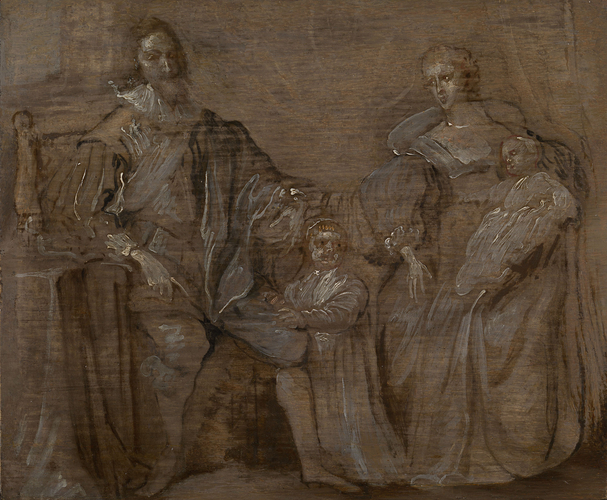
We then re-examined the provenance of the Royal Hospital painting, hoping to discover which member of the Ireton family had sold it to the Commissioners in 1700. There are only three possible Iretons at this date;
First, Dyas’s candidate, the soldier Henry Ireton MP, King William III’s Equerry and Gentleman of the Horse, son of Cromwell’s General. We were inclined to rule him out. As a Lieutenant Colonel of the 2nd Troop Horse Grenadiers – with a fortune in East India Company stock – he would have been more likely to donate the painting to the Royal Hospital.
Then there are Henry Ireton’s cousins, the brothers Henry and German. Henry and German were the sons of John Ireton – General Ireton’s brother, a thorough Roundhead. John Ireton was Lord Mayor in 1658 for which he was knighted by Oliver Cromwell. He was lucky to survive the Restoration in 1660, but was in and out of the Tower of London, and could have witnessed his brother’s body being exhumed and beheaded at Tyburn along with those of the other regicides Oliver Cromwell and John Bradshaw.
Like many Roundhead grandees, John Ireton bought at the great auction of the King’s Goods held after Charles’s execution in 1649. And he bought a remarkable object, the Garter that the King had been wearing at his execution, with the motto of the Order of the Garter worked in 412 diamonds. Ireton paid £205 for the Garter, more than was paid for the Leonardo Salvator Mundi sold in the same sale for £30 and now the subject of some debate as to whether it is the painting sold by Christie’s for £450 million pounds last year.
Did John Ireton also buy a copy of the Great Peece to go with this extraordinary trophy? He died in 1690, but was one of his sons the ‘Ireton’ who sold the painting to the Commissioners of Chelsea Hospital ten years later?
The three commissioners were the men whose portraits you can see in this room. Sir Christopher Wren, Sir Stephen Fox and the Governor, the Earl of Ranelagh, a loveable man who – in his own words had a ‘generalist approach to book keeping’ and was subsequently, as is well known, expelled from Parliament for embezzling £900,000 of public funds, a mindboggling sum in the 18th century.
The brothers Henry and German Ireton had access to these circles. Through their cousin the King’s Equerry, and through their own work for the Treasury. Henry was Collector of the Excise in Kent from 1697, until the Lord Treasurer dispensed with his services on 26 May 1702 after a string of misfortunes. One on occasion he was robbed by highwaymen; on another he over collected the tax.
His brother German Ireton had been one of His Majesty’s Agents for Taxes since 1700 and was reappointed by Queen Anne on the same day that his brother was fired. German prospered and died a High Court judge in 1710. His picture collection was later sold at his Chambers in Gray’s Inn, but no catalogue survives.
Either brother could have sold the painting to the Royal Hospital in 1700, but our burning question is whether there is any relation between Van Dyck and this version in the Royal Hospital and, therefore by extension, between King Charles I and this painting?
And, we believe, the root of the answer lies in Antwerp not in England. It lies in the 17th century Antwerp painter’s studios and, most especially, the studio practice of Peter Paul Rubens. And it was in Rubens’ studio that the Van Dyck worked as a young man and was described in a 1620 letter as Rubens’ famous allievo – his most gifted disciple.
For a painting to leave his studio as a ‘Rubens’ there were at least four distinct categories, as Rubens explained in a letter to the English Ambassador and collector, Sir Dudley Carleton, dated April 18, 1618, at the time when Van Dyck was collaborating with him:
The four categories of a painting which could be called a Rubens were, according to the master himself:
So, only retouching by Rubens on a painting was required before it could leave his studio branded as a work of his own. And through his experience in Rubens’ studio this definition of an original also extends to Van Dyck in England.
Did Charles I commission copies of the superb, ground breaking and well-received Greate Peece from Van Dyck? The answer to that question is a resounding yes. We know that one copy was delivered by Van Dyck to Marie de Medicis, Queen Henrietta Maria’s mother, in 1633 when she was living in exile in Brussels.
We also know there were more copies in the Royal Collection made during Van Dyck’s lifetime. The painter Remigius Van Leemput was paid £50 by Warrant in 1647 for a copy of the Greate Peece in the Royal Collection, but there has historically been some doubt as to when the picture itself was painted.
Re-examining the original warrant in the British Library the dating is clear. Leemput was commissioned ‘by the appointment of the Right Honourable Phillip Earle of Pembroke; for his Majestie’, that’s to say by Pembroke in his role as Lord Chamberlain, a post from which he was dismissed in July 1641 – five months before Van Dyck died.
And the warrant states that Leemput is to paint ‘according to the Coppie of the Great Peice at Whitehall’, so he wasn’t copying Van Dyck’s original painting, but another early copy of the Van Dyck in the Royal Collection.
This tallies with the 1649 inventories of King Charles I’s goods taken after his execution which, in addition to Van Dyck’s original, include a copy of the Greate Peece of Vandyke at Whitehall, sold for £60 to Emanuel de Critz, who also bought the original version for £150 and The King Queen Prince and Princess after Vandyke at Hampton Court, valued at £30. No buyer is listed for the Hampton Court copy.
So we have evidence of several, early copies, hanging in the Royal Palaces and also sent as gifts to close royal relations. Could this one behind me be one of those commissioned by Charles I and completed in Van Dyck’s studio, as Lionel Cust thought and, which, under Flemish studio practices would have left the studio as a painting by Anthony Van Dyck if the master had retouched it? It depends on whether there is retouching or intervention in the painting by Van Dyck himself.
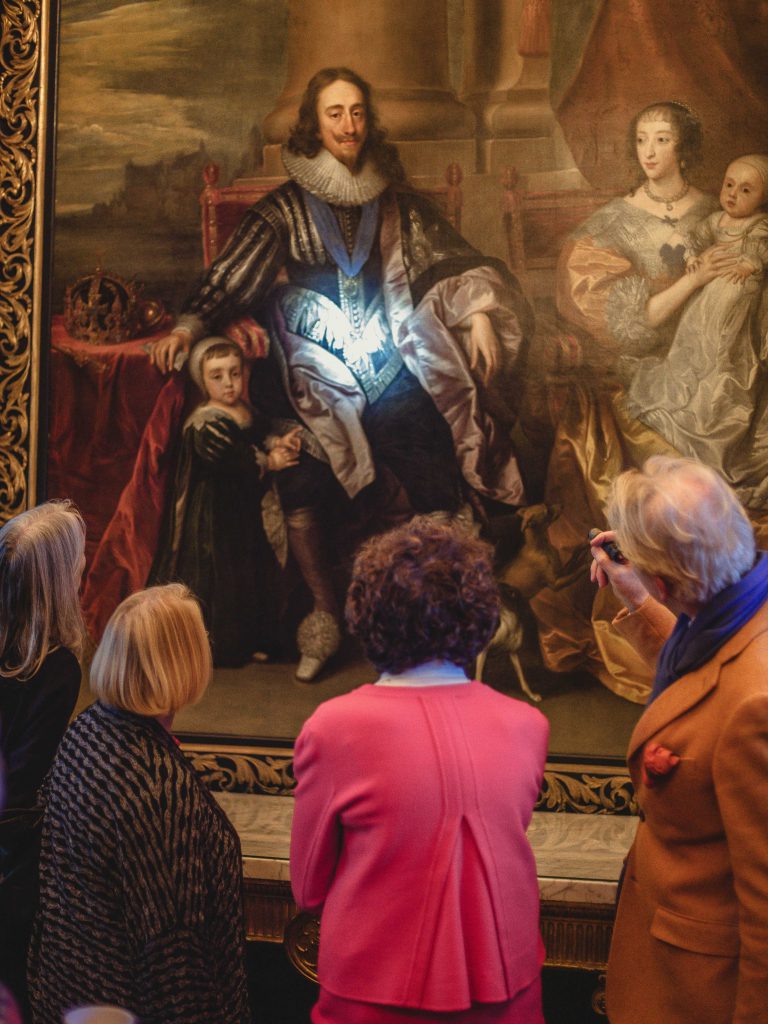
And the answer to this lies only in a visual examination of the painting itself. And we are very grateful for the generous assistance of the painting conservator Simon Gillespie, who many of you might know from the well regarded and deservedly popular art historical television programmes, Fake and Fortune and Britain’s Lost Masterpieces, and who has got ‘up close and personal’ with many Van Dyck masterpieces over the course of his career.
Given that this painting is over four hundred years old it has survived remarkably well. The darker red lacquer pigment used for shadowing the red vermillion of the tablecloth to the left and of the chairs for the monarch and his queen is well preserved although this was one of the most fragile pigments of the time.
On the other hand, the faces of the queen and her daughter to the right have suffered by wear, possibly overcleaning, and subsequently been overpainted by a less subtle hand than that of a Flemish master. Therefore, we need to look at the other passages of the painting to permit a fair judgment of the picture’s real quality. In contrast to the unsubtle overpainting are the vivid brushstrokes of Maria Henrietta’s yellow dress, where the shadows are suggested by touches of contrasting blue grey, and in the painting of the King’s silk linings and stockings, where the line of the right leg is defined by a masterly and dashing stroke of dark red. And the painting of other particular passages, notably the King’s head and ruff is superb – ‘90% quality’ in Simon’s words, top notch studio of Van Dyck. Moreover, the subtle strengthening of the contours of the two dogs points to a hand which was well acquainted with Van Dyck’s painting practices. For these reasons, the Chelsea painting has therefore justly been judged one of the best early versions of the Great Peece.
But, as you will see when you look closely at the picture after this lecture, and Simon has kindly agreed to focus his torch on the pertinent passages, the painting consistently shows delicate highlights where the light touches the protruding passages of figures and objects. Strokes like this make the picture three dimensional. Some of these added highlights are tiny but telling. The highlights on the bridge of the King’s nose bridge and at the right contour of his left eye are fluid, rhythmic and outstanding, as are the brushstrokes which structure the Monarch’s right leg, the dashing highlights of the Queen’s drapery and on the dogs. The face of the young Charles II is obviously much better painted than his cap.
So, where does this leave us at the end of the trail begun by the Chelsea Corporal Pensioner Charles Dyas and followed by the Surveyor of the King’s Pictures Sir Lionel Cust over a hundred years ago?
We have ascertained that the painting in the Royal Collection at Windsor is Van Dyck’s original. But is this painting of the Greate Peece at the Royal Hospital, a Van Dyck or not a Van Dyck? The answer is yes – in 17th century terms this is a Van Dyck. This painting, probably commissioned by Charles I to hang in a royal palace or to be given as a gift, would have left Anthony Van Dyck’s studio in Blackfriars, mainly produced by an assistant but retouched and finished by the master himself, as an original Van Dyck.